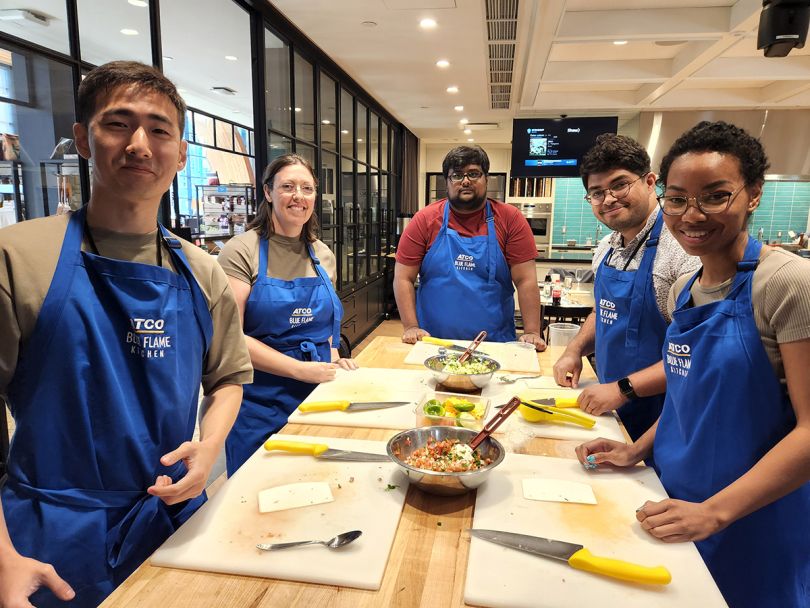Every Friday, Engineering Manager Chris Menezes feels a thrill: He gets to learn about all the technical phenomena his team encountered during the week. Throughout the half-hour meeting aptly dubbed “computer lab,” engineers discuss subjects ranging from relevant niche technologies to the latest software making daily processes easier. There’s just one requirement for the brief presentations: They need to be informal. The goal is to cultivate a welcoming atmosphere in which everyone feels free to share.
“I think it’s a good practice to keep the team sharing insights about the tools and the artistry of being a software engineer,” Menezes said. “It’s not just about delivering projects, it’s about building a long-term skill set. We’re building a community of practice where we’re all working to better our craft and improve how we approach problems.”
Menezes’s approach to communal team building can be found in action all around other parts of Validere. As part of a recently launched initiative at the energy solutions platform, biweekly time slots have been dedicated to playing online games together and asking icebreaker questions as a team. And while having fun is an important factor behind these events, it goes even deeper for leadership: Social cohesion leads to trust between engineers, and trust builds a culture of ownership.
But if engineers are already individual contributors with autonomy over their projects, why is establishing an ownership-centered culture so important?
For Software Development Manager Ryan Wakelam, it’s because arming engineers with an increased sense of ownership is the most effective way to encourage them to take action with confidence and knowledge — not just for themselves, but for the success of the entire group.
“When the team needs to ask permission for resources before taking action, it decreases their sense of ownership,” he said. “If you don’t create a safe place for people to take risks, they will feel like they are working on someone else’s project and will not treat it like their own. They’re more likely to wait for others to act first.”
According to Data Engineering Manager John Nguyen, uniting teams around a culture of ownership is a culmination of three things:
INCORPORATING A CULTURE OF OWNERSHIP
- An environment of autonomy to ideate and experiment
- A sense of purpose and alignment so that a team or individual can understand how their contribution fits into the goals of a larger organization
- The accountability and empowerment to see work through not just to completion, but to the value in a customers’ hands.
At Validere, Wakelam’s safe environment of ownership goes a long way. Whether employees are incorporating new hires into the tight-knit culture or going the extra mile to build a presentation covering complex processes, the engineering team’s contributions are anything but individual — they’re united.
“It’s enlightening getting to know what’s on people’s bucket lists and gaining personal insights into their lives,” Menezes added. “Sometimes in a remote work environment, you don’t get the chance to learn about the depth of your colleagues and — it sounds kind of cheesy — knowing what’s important to people actually makes your experiences even better.”
Built In sat down with Menezes, Nguyen and Wakelam to learn more about what a culture of engineering looks like in practice.

What do you think is unique about your culture compared to other companies?
Wakelam: My immediate team is very collaborative and people go out of their way to help each other out. I have an individual who just started a few weeks ago, and then I had a new person who started today. The guy that started three weeks ago made sure to add the new individual to all of our meetings before I even made it into the office. The brand-new hire said he felt like he was already part of the team and had everything he needed to get started before I could even step in.
“In a culture of ownership, everyone feels compelled to contribute to the success of the team — no one just sits back in silence with their camera off.”
Menezes: A lot of the folks here on our data science and engineering teams take a hypothesis-driven, scientific mindset to explain something or build a product. We try to validate the assumptions we’re making, do experiments and then come back to the problem. We really hold ourselves accountable to finding out the right answer and not just being tied to our own individual solutions to problems.
What does ownership mean to your team at Validere?
Menezes: A culture of ownership operates at multiple levels — individuals naturally own their individual work products. But when scaling an organization, it’s crucial that leaders influence teams to own problems. At the individual level, a culture of ownership is one where everyone on the team cares about excellence. They feel empowered to make changes — whether that’s to a codebase, team processes or even the fundamentals of a product. Individuals feel confident that they can rely on their teammates to make good decisions because everyone is accountable to the other owners.
When a team owns a problem space or a product, they provide a bedrock for other teams to build off of their collective outputs. A team really owning a problem area means that others can trust they can build off of it and the team will meet their commitments.
What are the essential behaviors for a leader looking to exemplify and spread a culture of ownership across a team of engineers?
Menezes: Leaders need to be owners themselves — it means all of the team’s problems are also their problems, and no problem should be left unattended. If a problem or issue comes up, it has to be triaged. It doesn’t mean that all problems need to be addressed, but leaders must be explicit about what kinds of problems should be prioritized and handled by the team. Without this, teams don’t know what problems fall under their purview. If an organization collectively ignores a certain type of problem, it becomes embedded in the decision-making process of everyone in the organization: “This kind of thing is just something we let burn.”
“To spread a culture of ownership, leaders need to be owners themselves — it means all of the team’s problems are also their problems, and no problem should be left unattended.”
Nguyen: Transparency is crucial to creating an environment where the team can be aware and connected to the reasoning behind their work, their purpose and how it aligns to a larger purpose. They must also be receptive: A large contributing factor is empowerment, and leaders should solicit feedback and contribute to an environment where ideas, concerns and initiatives can be openly shared.

What was your biggest challenge in spreading a culture of ownership when you first became a leader, and how did you overcome it?
Menezes: One of the biggest challenges is training folks to understand that the problems we pay attention to are actually chosen. No organization can tackle all types of problems. A small startup may be willing to take on technical debt and have an inconsistent architecture for some time if it means that they can get a product out faster. A larger engineering organization might prioritize having a consistent technology platform, even if it slows down delivery of a project. The broad strokes solution to this is to coach individuals to align how they operate in their jobs with the problems that the business cares about. For engineers, a lot of the time, this is focusing less on the technology and more on the business problems at hand.
REWARDING CURIOSITY WITH PROFESSIONAL GROWTH
Nguyen: Determining the boundaries of ownership and being explicit around which problems individuals or the team should be solving. It was an easy trap to fall into — particularly in a smaller organization — to try and solve every problem, and as a result lose focus and alignment. The solution to this has largely been very deliberate and aware about the tradeoffs we routinely have to make to deliver work and align our decisions with the larger purpose of the organization.
What is significant about your day-to-day experience at Validere? What would you say to a potential new hire?
Wakelam: All the people on my team are more than willing to go out of their way and work extra hours if it means helping out somebody else on their team. I had an individual who created a plan for moving a project forward, and he took personal time to record a video and go over a bunch of code so that he could disseminate it for everyone to explain the approach.
Menezes: As a manager, I believe it’s important to empower employees to learn something they’re not confident about and deliver on something that they didn’t even think they could accomplish beforehand. For example, I gave someone on my team the opportunity to learn how to use an unfamiliar tech tool. By allowing others to invest time in learning, they can deliver value that they never even thought possible.








